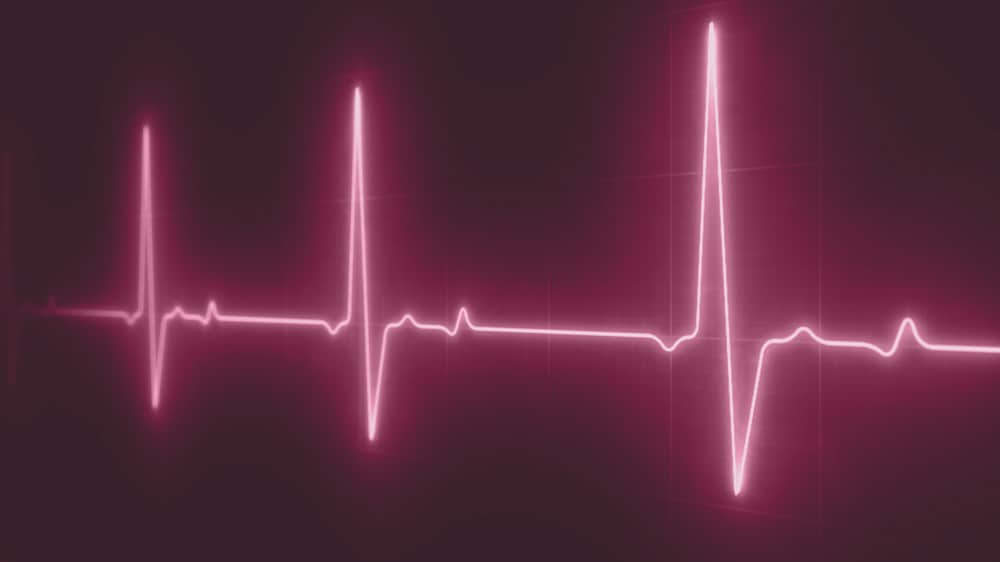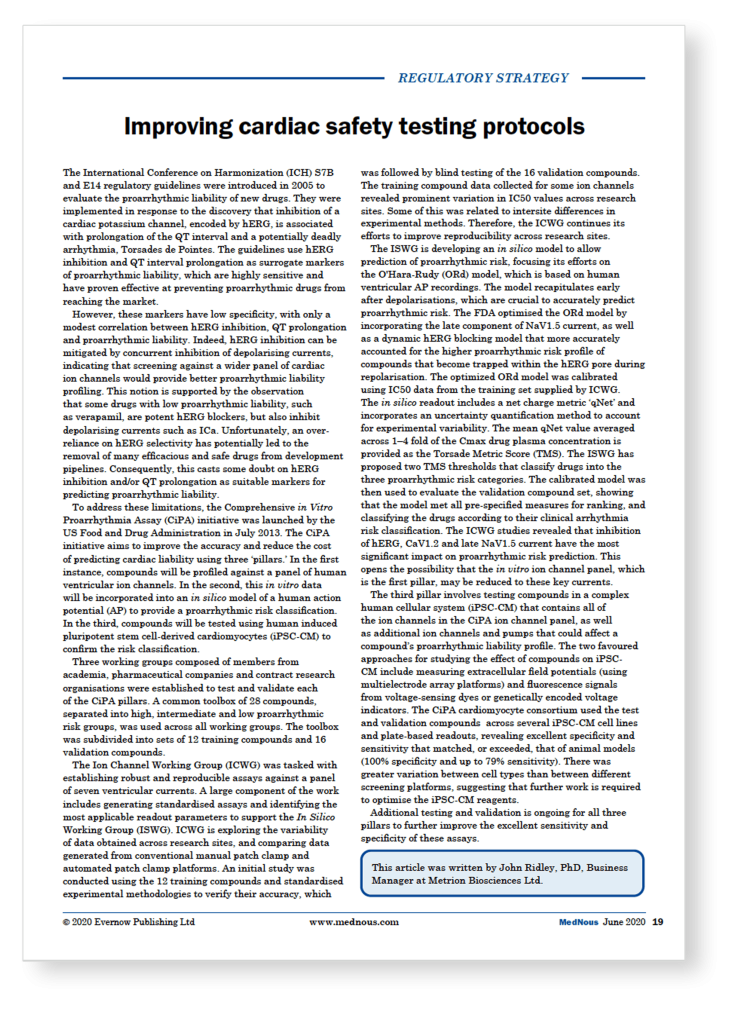Written by John Ridley PhD
The regulatory guidelines
The International Council on Harmonization (ICH) S7B and E14 regulatory guidelines were introduced in 2005 to evaluate the proarrhythmic liability of new drugs. They were implemented in response to the discovery that inhibition of a cardiac potassium channel (encoded by hERG) is associated with prolongation of the QT interval and a potentially deadly arrhythmia, Torsades de Pointes. ICH S7B and ICH E14 utilise hERG inhibition and QT interval prolongation as surrogate markers of proarrhythmic liability, which are highly sensitive and have proven effective at preventing proarrhythmic drugs from reaching the market.
However, these markers have low specificity, with only a modest correlation between hERG inhibition, QT prolongation and proarrhythmic liability6. Indeed, hERG inhibition can be mitigated by concurrent inhibition of depolarizing currents3, indicating that screening against a wider panel of cardiac ion channels would provide better proarrhythmic liability profiling.
This notion is supported by the observation that some drugs with low proarrhythmic liability (e.g. verapamil) are potent hERG blockers, but also inhibit depolarising currents such as ICa. Unfortunately, an over-reliance on hERG selectivity has potentially led to the removal of many efficacious and safe drugs from development pipelines. Consequently, this casts some doubt on hERG inhibition and/or QT prolongation as suitable markers for predicting proarrhythmic liability.

The launch of a new CiPA initiative
To address these limitations, the Comprehensive in Vitro Proarrhythmia Assay (CiPA) initiative was launched by the FDA in July 2013. The CiPA initiative aims to improve the accuracy and reduce the cost of predicting cardiac liability using three ‘pillars’:
- Compounds will be profiled against a panel of human ventricular ion channels
- This in vitro data will be incorporated into an in silico model of a human action potential (AP) to provide a proarrhythmic risk classification
- Compounds will be tested using human induced pluripotent stem cell-derived cardiomyocytes (iPSC-CM) to confirm the risk classification derived from the in silico model
Three Working Groups composed of members from academia, pharmaceutical companies and CROs were established to test and validate each of the CiPA pillars. A common toolbox of 28 compounds, separated into high, intermediate and low proarrhythmic risk groups, was used across all working groups. The toolbox was subdivided into sets of 12 training compounds and 16 validation compounds.
The role of the Ion Channel Working Group
The Ion Channel Working Group (ICWG) was tasked with establishing robust and reproducible assays against a panel of seven ventricular currents. A large component of the work includes generating standardized assays and identifying the most applicable readout parameters to support the In Silico Working Group (ISWG). ICWG is exploring the variability of data obtained across research sites, and comparing data generated from conventional manual patch clamp and automated patch clamp platforms.
An initial study was conducted using the 12 training compounds and standardised experimental methodologies to verify their accuracy, which was followed by blind testing of the 16 validation compounds. The training compound data collected for some ion channels revealed prominent variation in IC50 values across research sites4. Some of this was related to inter-site differences in experimental methods. Therefore, the ICWG continues its efforts to improve reproducibility across research sites and to devise best working practices for CiPA, whilst providing additional data to help test and validate the in silico AP model.
The role of the ISWG
The ISWG is developing an in silico model to allow prediction of proarrhythmic risk, focusing its efforts on the O’Hara-Rudy (ORd) model, which is based on human ventricular AP recordings. The model recapitulates early after depolarisations, which are crucial to accurately predict proarrhythmic risk7. The FDA optimized the ORd model by incorporating the late component of Nav1.5 current, as well as a dynamic hERG blocking model that more accurately accounted for the higher proarrhythmic risk profile of compounds that become trapped within the hERG pore during repolarization.
The optimized ORd model was calibrated using IC50 data from the training set supplied by ICWG5. The in silico readout includes a net charge metric “qNet” and incorporates an uncertainty quantification method to account for experimental variability5. The mean qNet value averaged across 1–4 fold of the Cmax drug plasma concentration is provided as the Torsade Metric Score (TMS).
The ISWG has proposed two TMS thresholds that classify drugs into the three proarrhythmic risk categories. The calibrated model was then used to evaluate the validation compound set6, showing that the model met all pre-specified measures for ranking and classifying the drugs according to their clinical arrythmia risk classification.
The ICWG studies revealed that inhibition of hERG, Cav1.2 and late Nav1.5 current have the most significant impact on proarrhythmic risk prediction6. This opens the possibility that the in vitro ion channel panel (Pillar 1) may be reduced to these key currents.
Testing compounds in iPSC-CM
The third Pillar involves testing compounds in a complex human cellular system (iPSC-CM) that contains all of the ion channels in the CiPA ion channel panel, as well as additional ion channels and pumps that could affect a compound’s proarrhythmic liability profile.
The two favoured approaches for studying the effect of compounds on iPSC-CM include measuring extracellular field potentials (using multielectrode array platforms) and fluorescence signals from voltage-sensing dyes or genetically encoded voltage indicators. The CiPA cardiomyocyte consortium used the test1 and validation2 compounds across several iPSC-CM cell lines and plate-based readouts, revealing excellent specificity and sensitivity that matched, or exceeded, that of animal models (100% specificity and up to 79% sensitivity). There was greater variation between cell types than between different screening platforms, suggesting that further work is required to optimise the iPSC-CM reagents.
A considerable amount of effort has been expended towards validating the three pillars of CiPA and using this data to revise ICH guidelines8. Additional testing and validation is ongoing for all three pillars to further improve the excellent sensitivity and specificity of these assays, with further work required to optimise iPSC-CM reagents to allow the development of more reproducible assays.
References
- Blinova et al., (2017) Comprehensive Translational Assessment of Human- Induced Pluripotent Stem Cell Derived Cardiomyocytes for Evaluating Drug-Induced Arrhythmias. Tox Sci 155: 234- 247.
- Blinova et al (2018) International Multisite Study of Human-Induced Pluripotent Stem Cell- Derived Cardiomyocytes for Drug Proarrhythmic Potential Assessment. Cell Reports 24: 3582–3592.
- Kramer et al., (2013) MICE Models: Superior to the HERG Model in Predicting Torsade de Pointes. Nature Sci Rep 3: 2100.
- Kramer et al., (2020) Cross-site and Cross-Platform Variability of Automated Patch Clamp Assessments of Drug Effects on Human Cardiac Currents in Recombinant Cells. Sci Rep. Mar 27;10(1):5627.
- Li et al., (2017) Improving the In Silico Assessment of Proarrhythmia Risk by Combining hERG (Human Ether-à go go-Related Gene) Channel–Drug Binding Kinetics and Multichannel Pharmacology. Circ Arrhythm Electrophysiol 10: e004628.
- Li et al., (2018) Assessment of an In Silico Mechanistic Model for Proarrhythmia Risk Prediction Under the CiPA Initiative. Clin Pharm Therapeutics: 10.1002/cpt.1184.
- Mirams et al., (2011) Simulation of multiple ion channel block provides improved early prediction of compounds’ clinical torsadogenic risk. Cardio Res 91: 53-61.
- https://database.ich.org/sites/default/files/E14S7B_IWG_Concept_Paper.pdf
Acknowledgements
Thank you to Dr John Ridley, Metrion Biosciences’ Business Manager for writing this article and to MedNous for publishing this work.
This article was published in the June 2020 edition of MedNous, a publication of Evernow Publishing Ltd.

Business and Strategic Partnerships Executive
John Ridley PhD
John has more than 10 years’ experience working in ion channel drug discovery. This experience was obtained firstly as a Senior Scientist at Xention, where he was involved in the discovery of ion channel blockers for atrial fibrillation, neuropathic pain and autoimmune diseases, and then as the Business Development Manager at Metrion Biosciences.

John Ridley PhD
